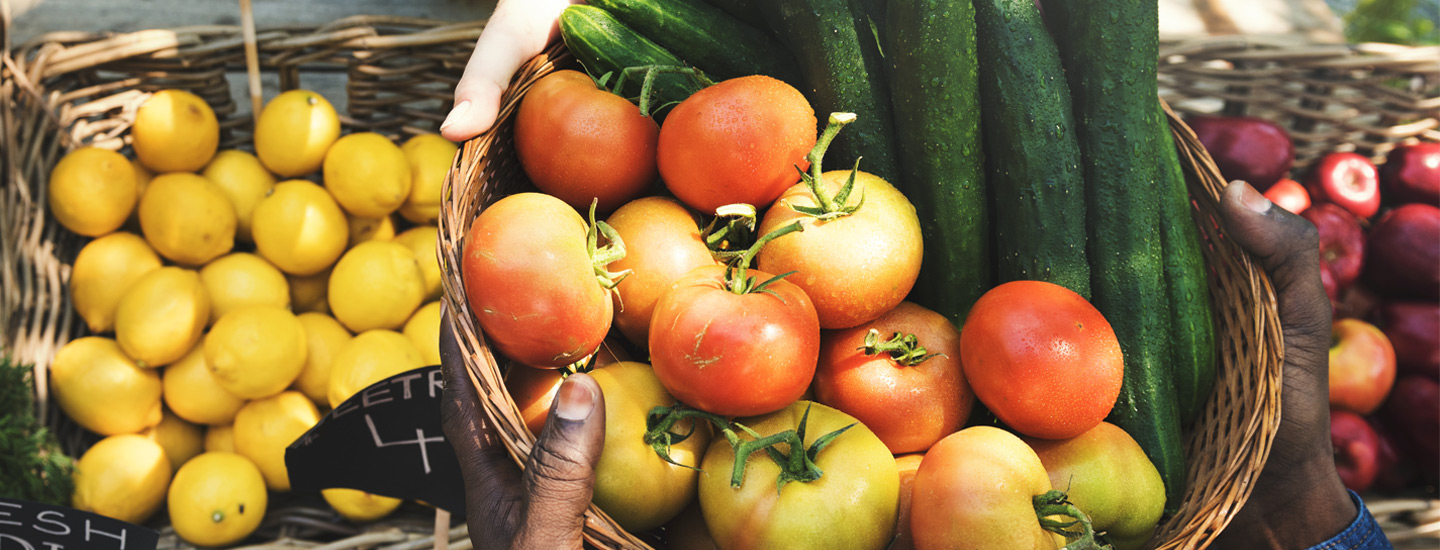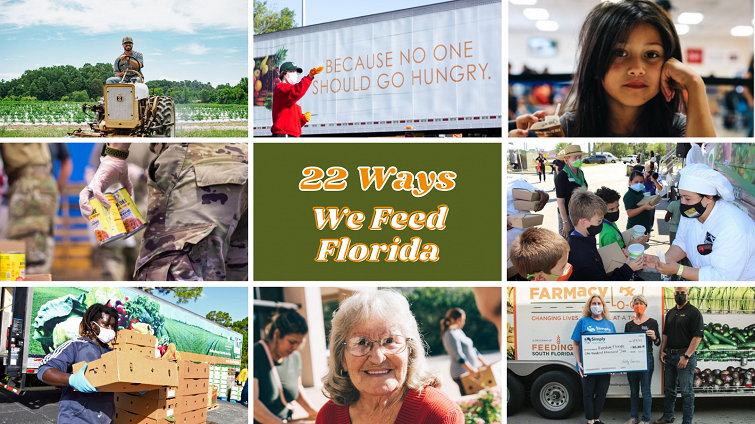For nearly three decades, the Feeding Florida network of food banks has had one main mission: to offer life-changing resources to help combat hunger and food insecurity in the state. Through several programs, partnerships and innovative solutions, our network helps feed the 3.1 million Floridians experiencing hunger year-round. As we kick off 2022, we want to highlight 22 different ways we help to feed Florida- shortening the line and alleviating hunger throughout Florida.
1. 12 Network Member Food Banks
Feeding Florida unites 12 Feeding America member food banks who work with more than 2,400 community-based partner agencies to provide food directly to individuals and families in need. They cover all 67 Florida counties every single day.
2. Year-round Distributions
Our Feeding Florida food banks are unique because they provide support to Floridians 365 days a year. Hunger doesn’t take a break for holidays or hurricanes, and neither does Feeding Florida.
3. Fresh Access Bucks
Our Fresh Access Bucks program offers Floridians the unique opportunity to purchase fresh, local produce at farmers markets and select retail outlets using SNAP dollars. FAB is a USDA-funded, statewide nutrition incentive program that increases the purchasing power of SNAP recipients to buy fresh fruits and vegetables at farmers markets, produce stands, CSAs, mobile markets, and community grocery outlets.
4. Children’s Programs
Did you know that the largest population of food insecure individuals in Florida are children? 1 in 5 Floridian children experience hunger daily, which is why our network has a wide range of children’s feeding programs. During the school year, our food banks distribute backpacks for students to take home for weekend meals, since most food insecure children only receive meals during school hours, as well as in-school breakfast, lunch and after care meals and snacks.
5. Produce Recovery & Farmers Feeding Florida
Florida makes enough food to feed everyone in the state, and then some. We are lucky to have such bounty in our state, so the network works with local growers through our Farmers Feeding Florida program to recover produce and get it to the people who need it most. These partnerships with Florida farmers and packers throughout the state helps to rescue and distribute wholesome and cosmetically blemished produce to those who lack access to fresh produce. The initiative offsets out-of-pocket costs for packing materials to enable them to scale up donations to multiple truckload quantities.
6. TEFAP
The Emergency Food Assistance Program provides American-grow, USDA foods and administrative funds to states, like Florida, to supplement the diets of individuals experiencing hunger. This TEFAP support is seen within our network in the form of food or funds for food, and was essential to helping provide for food insecure and hungry individuals during the COVID-19 pandemic.
7. Mobile Pantries
The Mobile Pantry Program directly serves clients in areas of high need to supplement other hunger-relief agencies in that area. Through a Mobile Pantry, a truckload of food is distributed to clients in pre-packed boxes or through a farmers’ market-style distribution where clients choose to take what they need. Several Feeding Florida food banks have expanded their mobile pantry programs and mobile grocery stores to fill gaps in their network of partner agencies. The expansion of this program allows the food banks to ensure more of their clients have proper access to food sources when they can’t access a local food pantry.
8. FoodRx Programs
One of the main side effects of hunger is a weakened immune system, and lack of nutrition often leads to worsening health conditions and ailments. Our FoodRx programs aim to combat these health issues by providing medically tailored meals or “prescriptions” for nutritious foods to individuals experiencing health issues as well as food insecurity. These FoodRx programs currently exist at our Feeding South Florida, Feeding Northeast Florida and Feeding Tampa Bay food banks.
9. Food Pantries
Food pantries are a traditional solution to hunger, dating back to the 1960s. Our Feeding Florida food pantries can be found in churches, schools, community centers and nonprofits across the entire state. These pantries (we call them partner agencies) provide shelf stable goods, and often times meats and refrigerated goods, either for free or for low costs.
10. Culinary Programs & Community Kitchens
As a network, we aim to equip Floridians with the skills needed to ensure a stable career.Treasure Coast Food Bank’s unique Culinary Training Academy provides students with the culinary and life skills training needed to pursue a sustainable career in the food industry. Several of our network member food banks also offer community kitchens, which offer fresh, hot meals prepared daily by a team of chefs.
11. Senior Programs
One unexpected face of hunger is that of senior citizens. There are several contributing factors to senior hunger in Florida, such as fixed income, lack of transportation, increased healthcare needs and more. Our food banks offer a variety of senior programs to help put fresh food on the plates of hungry seniors. Some programs offer nutrient-rich meal kits delivered right to their front door or client-choice food pantries on site at senior community centers.
12. Workforce Development
At Feeding Florida, we believe hunger is the result of an under-resourced household, which is why we seek to shorten the line by providing opportunities for growth and employment for our families. Several of our food banks offer workforce development programs, such as Second Harvest of Central Florida’s Culinary Training Program, with the hopes of providing individuals with the chance to nurture a new skill and secure employment.
13. Rural Services
Feeding Florida is dedicated to feeding all Floridians, not those just those who live in easily accessible areas. Food desserts are low-income tracts where a substantial percentage of the population lacks access to supermarkets or large grocery stores. Part of our mission is to provide fresh produce and meal items to these food desserts across the state. Thanks to the Fresh Access Bucks program and mobile distributions, we are able to reach more rural populations and provide access to healthier food options.
14. Military Programs
Another unexpected face of hunger is active-duty military and veterans across the state. After years of serving their country, many veterans are not able to find long-term work or high-paying jobs, either because of physical injury, mental stress or trouble assimilating with civilian life. As a result, many veterans end up jobless, homeless and hungry. This is why our food banks offer military feeding programs to ensure those who have served our country are also having their basic needs met.
15. Disaster Relief
As a core member of Florida’s Emergency Management team, Feeding Florida partners with the Division of Emergency Management to pre-stage state resources strategically throughout Florida that can be quickly mobilized to ensure communities are prepared. Feeding Florida collaborates with Feeding America, Voluntary Organizations Active in Disaster (VOAD), FEMA and other disaster responders to prepare for catastrophic events. Feeding Florida is an integral part of Florida State Mass Care team, helping to plan response and recovery activities and to serve our neighbors when disaster strikes.
16. Healthcare Partnerships
Our healthcare partners have helped to create and fund many programs to help Florida’s food insecure, such as our FoodRx programs, medically tailored meals, and most recently funding for mobile distributions to provide additional nutritional services for the Florida zip codes with the highest hunger rates. Thanks to the generosity of our partners, our network member food banks can further impact millions of Floridians each year.
17. Meal Deficit Metric
Our Meal Deficit Metric is a study conducted by Mari Gallagher Research & Consulting Group that reveals missing meals and key demographic data at the block group and census track level. This data helps us pinpoint hunger at a hyper-local level so our food banks can better allocate resources to the areas with the highest number of weekly meals missed. While traditional countywide data has served an important purpose for food bank networks over the decades, this unprecedented research means that we can utilize resources to target hunger needs more effectively in our local communities.
18. Imagine Tag
Combatting hunger in the state of Florida can be as easy as purchasing a license plate, thanks to our specialty plate, the Imagine Tag. When you purchase the Imagine License Plate featuring the iconic self-portrait of John Lennon, your dollars go right back to our 12 network member food banks which feed hungry Floridians year-round.
19. Retail Support
One source of support that helps sustain our network is our national retail partnerships. Thanks to partnerships with Walmart, Sam’s Club, Food Lion, Kroger, Publix, Target and BJ’s Wholesale Club, we are able to access store donations and collect billions of pounds of food to distribute across the state.
20. Corporate Donations
Oftentimes our network is chosen as the charity of choice for a corporation’s philanthropy efforts, state conference, or seasonal campaign. The donations made through these fundraisers are a wonderful service to the food banks and to individuals they serve. Every time a corporation chooses Feeding Florida, they are helping to promote and fund our 12 food banks, which directly helps to expand the impact we make on the lives of hungry Floridians across the state.
21. Summer Feeding
While the summer months mean fun and play for some kids, 21 percent of children in Florida are currently experiencing food insecurity. When school lets out for summer break, many children are left without a consistent source of food, adding to the other struggles they face like development and health. Our food banks combat this by providing summer feeding programs, which offer a wide range of options for parents to provide food for their kids during the summer months, from mobile food pantries and drive-thru food deliveries to grab-and-go meal packs.
22. SNAP Outreach
Not only does our network help connect SNAP recipients to local farmer’s markets and retail stores where those dollars are accepted through Fresh Access Bucks, we also help enroll individuals into the SNAP program. We are dedicated to providing individuals with fresh produce and goods, but also helping them access the resources needed to sustain and support their families for years to come.


